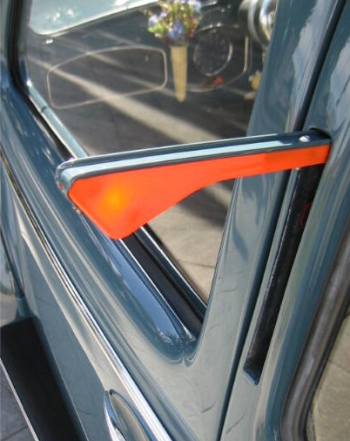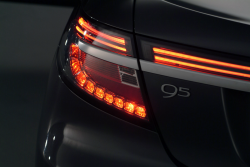Manoeuvre
An example of positioning when turning right taken from our learner's video series
 Having sorted out what you should be doing with your mirrors and signals, it's time to consider the manoeuvre itself!
Having sorted out what you should be doing with your mirrors and signals, it's time to consider the manoeuvre itself!
Here, manoeuvre means any action that is taken to deal with a hazard. Remember that a hazard is anything that requires you to alter your speed or road position.
This will happen when, for example, you have to slow down for a red light; turn right or left; pass parked cars, or anything else that affects your speed and/or position.
Your manoeuvre might just mean driving forward in a straight line. Pedestrian crossings are a good example of a potentially dangerous hazard which do not require a change of direction.
These, and many other situations, will all require application of the Mirrors - Signal - Position - Speed - Gear routine. When you see the word manoeuvre in The Highway Code it is simply referring to your road Position, Speed Gear and of course. effective observation.
Position
Take care to position your vehicle correctly for all manoeuvres.
As touched on in the 'signals' advice, other drivers will often take more notice of your 'body language', i.e., the car's position than your signals. You might have encountered a situation where another driver said (or you thought yourself) "Didn't you see my signal?"
The chances are that the signal was seen, but the brain took more notice of the 'body language' - the car's position. Before changing position, you must check your mirrors to make sure that it is safe and give a clear signal if it will help other road users.
Speed
As (or after) you take up your position you can adjust your speed.
This is normally done by releasing the accelerator and braking. Positive reduction of speed should not normally be made before you change your position.
For example, if you were intending to turn right, on a road that is wide enough for vehicles to pass on your left side and you slowed down before starting to move into position, you would hold up the following traffic. Another example would be leaving a motorway - if you reduced your speed before entering the deceleration lane you could cause severe problem to following traffic.
Remember, although the Highway Code recommends Mirror - Signal - Manoeuvre, this does not mean that you have to restrict yourself to one mirror check.
The red traffic light example (here) earlier in this section demonstrates the importance of knowing what's behind at all times. To drive to an advanced standard you will need an extra mirror check (or two) before changing either your position or your speed.
An example of speed and gear when turning left taken from our learner's video series
Acceleration sense
If you are planning your driving well ahead, your speed will often be controlled by 'acceleration sense' Gaining good acceleration sense will lower your fuel costs, reduce wear and tear on your vehicle, reduce driving stress and give your passengers a more comfortable ride.
 Acceleration sense is the ability to predict the amount the road surface, camber, gradient, etc., will affect the way that the car slows down. If you get an opportunity to experienced a demonstration drive by an expert driver, perhaps a police class one driver or other advanced driving expert, you might be amazed at how little the brakes are used, despite the brisk speed of the drive - this is acceleration sense in action.
Acceleration sense is the ability to predict the amount the road surface, camber, gradient, etc., will affect the way that the car slows down. If you get an opportunity to experienced a demonstration drive by an expert driver, perhaps a police class one driver or other advanced driving expert, you might be amazed at how little the brakes are used, despite the brisk speed of the drive - this is acceleration sense in action.
A simple exercise to develop your acceleration sense is to drive on an open country road as if you had no brakes. Be sensible! Don't frighten yourself or other road users and don't take risks... But try to drive as far as possible without touching the brakes while maintaining good progress. Do this by 'reading the road' (covered later in this programme), planning ahead and releasing the pressure on the accelerator early.
Gear
When your speed is controlled, you can select the best gear for the manoeuvre (this may be first gear if you slow to a stop).
 Complete your change of speed before selecting the gear; remembering what you have learned about 'gears to go' and skipping gears where appropriate. the gears should not be used as a form of braking in normal driving situations.
Complete your change of speed before selecting the gear; remembering what you have learned about 'gears to go' and skipping gears where appropriate. the gears should not be used as a form of braking in normal driving situations.
The simple rule is get the speed right first, then select the gear. If you make a mistake, being in the wrong gear will be safer than travelling at the wrong speed, you can easily remedy a mistake with gears, however, a mistake with speed can be fatal. Having said that, your aim is to practise until you have both speed and gear correct!
There may be times when you are braking as you change gear. the 'old' rule used to be strict: finish braking before making your gear change, however, strict rules lead to inflexibility and this can be a danger in itself.
As road and traffic conditions become busier and modern gearboxes allow more flexibility with speed and gear selection, 'overlapping' (changing gear whilst braking') is now an accepted practice. However, despite the fact that overlapping is 'acceptable' you will probably discover that as your forward planning and acceleration sense improves, you will use the overlap technique less and less!
Observation
Up to now we have concentrated on observation to the rear. It's obvious that you should be looking to the front and aware of any potential dangers ahead at all times...
However, if it is so obvious to look to the front why do so many accidents occur? Simply because many drivers 'see' but don't  perceive.
perceive.
Looking entails more than just staring out of the windscreen. You need to keep your eyes moving and stay alert.
-
Will the cyclist turn?
-
Will the other driver see you?
-
Will the load slip off the truck?
-
Will the child run out?
This kind of active observation is the most important part of becoming a defensive driver and will be covered in more detail in section six (Reading the road).
Next: Step 6 - your practise sessions.